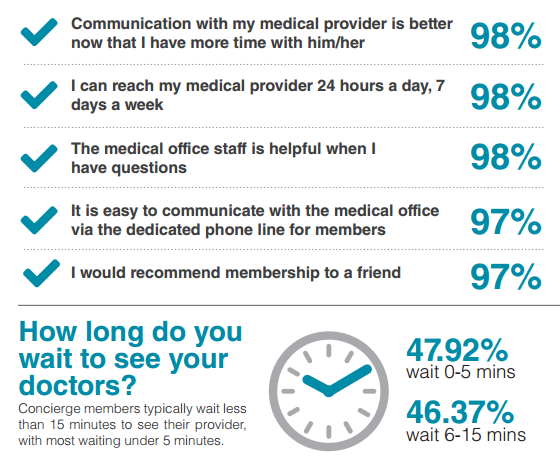Why Concierge Medicine Programs Boost Patient Satisfaction
"The measure of satisfaction is extremely high in concierge medicine because those who elect to do it are looking for the kind of benefits that are afforded them in concierge."
- Due to the many complications of healthcare reform and the many quality care initiatives being established by federal agencies and payers, both new and well-established alternative healthcare delivery models are cropping up. Concierge medicine fits into the latter category. With the number of benchmarks to meet and electronic documentation to file, many physicians are finding that they’re spending less and less time on direct patient care.

Doctors and patients who are searching for longer visits and more one-on-one customized care are turning increasingly to concierge medicine. Instead of relying on traditional health plans, physicians working in these healthcare delivery systems require membership fees from their patients.
One survey from Concierge Choice Physicians shows that patient satisfaction is high within concierge medicine with 98 percent of participants stating that communication and immediate contact with healthcare providers has improved. Additionally, 98 percent of survey takers are satisfied with office staff and their ability to answer questions while 97 percent would recommend the services to their friends.
To find out more about patient satisfaction and outcomes of concierge medicine, RevCycleIntelligence.com spoke with Wayne Lipton, Managing Partner at Concierge Choice Physicians.
RevCycleIntelligence.com: How does concierge medicine impact patient engagement and satisfaction?
Wayne Lipton: “Patient satisfaction in concierge care is extremely high. Satisfaction in a program that is consumer-driven is measured in two ways – one, by surveys, two by participation rates. There are two different kinds of concierge – one is the full model and the other is the hybrid model.”
“In a full model program, about two-thirds of the patients who decided to become members joined simply because they don’t want to have to change their doctor. The motivation is less about wanting the perks of the model and more about their satisfaction with their doctor, and not wanting to lose him."

“Patients in a hybrid program are able to switch back to the traditional practice with the same physician at any time, therefore it is important that patients continually see the value in their concierge membership. Our impressive re-up rate of 90% is the best indicator that our hybrid program doctors are meeting and in many cases exceeding their patients’ expectations. Concierge patients enjoy greater connectivity, more time, more convenience, more of a one-to-one mapping, and a bit more of an old-fashioned approach to healthcare in terms of the personal portion of the services.”
RevCycleIntelligence.com: Does concierge medicine lead to better health outcomes? In what ways?
Wayne Lipton: “There have been a couple of different studies that have pointed to better outcomes, but I am still not sure that the improved outcomes aren’t linked to the fact that the person who invests in a concierge program is the type of person who is proactive about their healthcare.“
“However, on the opposite side of that, when a doctor spends more time with an individual, the possibility exists of better outcomes, perhaps even better compliance. The real question is not whether there are better outcomes. I think the better question that’s been talked about most recently is – is it cost effective in getting a better outcome?”
“For instance, if you can call your doctor and you don’t have to run to an ER because you have a better connection to a particular doctor, that’s going to potentially limit the number of times that you use a more expensive service.”
“Is the fee paid for concierge service paid for by the savings that happen? That’s an insurance question which has been posed. My own personal experience is I am not sure that that is in fact true. It may be true, but I don’t think anyone has proven it one way or the other.”
“A patient who decides to participate in a concierge program, by that decision alone, is different from people of the same socio-economic background because it indicates an intensity of desire to manage their care and to be proactive in their healthcare. People who are proactive in their healthcare are inherently going to get a better outcome than those who are not.”
RevCycleIntelligence.com: How does the concierge payment model affect the revenue cycle of a medical practice?
Wayne Lipton: “We specifically analyze the revenue generated by physicians individually and collectively within a practice. The revenue per hour in a concierge program that we set up is usually twice the revenue rate per hour spent than they would generate in a traditional practice.”
“There are some practices in specialty care where the goal is not so much to enhance the revenue, but rather to sustain the existing revenue in a contracting environment. That’s been part of what happened several years ago. Now the revenue per hour or revenue per unit of work has been reduced in some specialty areas.”
“In today’s world, the good news is that the concierge programs and the pricing that we work with inevitably affects the practice in the aggregate dollars in a significant way – anywhere from 10 percent of revenue across the board to as much as 30 to 40 percent with the same amount of overhead.”
“It’s a very interesting balance. If you price is too high, you get too few members and it’s unstable. If you price it too low, it doesn’t add value to the practice. Pricing it at the right place is one of the pieces of the puzzle that we bring to the table.”
RevCycleIntelligence.com: What is the exact type of payment model that Concierge Choice Physicians uses and how does it impact patient care?
Wayne Lipton: “From the perspective of the patient, they’re paying for a product that is entirely built around non-covered services. The non-covered services are delivered as an expansion of what is currently covered. The doctor and the patients continue to utilize and participate in third party programs for the covered services.”
“Because in a hybrid program there is no dismissal of patients, the insurers still have a provider who takes care of traditional patients and concierge patients. Their satisfaction with this type of a program is extremely high. What the patient does is pay an out-of-pocket fee for these non-covered services in the form of a membership which entitles them to a defined set of services.”
“The other services that they would receive are the same type of services that are covered by their insurance, by Medicare, or another third party payer. That’s the basic concept of how it’s put together.”
“The doctor is compensated by those fees. We are paid for our services as a provider of administrative services along with marketing, support, and training services. We help structure this so that it best suits the needs of the practice and the needs of the patients.”
“Our unique hybrid approach enables patients to join the practice both on the traditional side or the concierge side. There’s a flow of new patients that come into the practice and the older patients get older. As they do, sometimes they believe that the concierge program may be appropriate for them as their lives change.”
